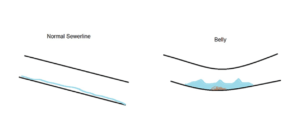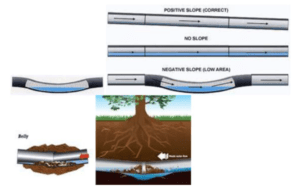Sewer Line Belly and Pipe Channeling Explained
Sewer Line Belly and Pipe Channeling Explained
What is a Sewer Line Belly?
A sewer line ‘belly’ is defined as a pipe holding water due to inadequate slope percentages at one or more sections of the lateral drain. A belly in a sewer line is often caused by geological events (soil movement/erosion), foundation settlement, inadequate soil compaction during installation, or a combination of various factors. Often, pipe bellies do not cause immediate or complete failure of the sewage system, however, bellies become problematic when/if debris collects and causes system blockage or backup.


What is Sewer Line Channeling?
Sewer line channeling occurs when running water cuts a course into the bottom of a sewer line over time (similar to the formation of a ravine, canyon or gully). In many cases, by the time a sewer line channel has become a problem, the bottom of the pipe may be in a state of failure. Failed or significantly deteriorated pipes (often discovered in dated cast iron drain pipes) provides an access point for tree roots, soil, and insects which typically lead to additional issues and complete drain line blockage.
What Are the Repair Options - Bellies?
Often, pipe bellies do not cause immediate or complete failure of the sewage system, however, bellies become problematic when/if debris collects and causes system blockage or backup. In most cases, it is not possible to determine if pipe settlement has stabilized or is ongoing. Due to this limitation, the possibility of increasing drainage flow disruption and future repair needs at seemingly inconsequential bellies/sags can not be ruled out. Professional opinion and repair/replacement recommendations to address pipe bellying will vary from one specialist to the next and is often decided on a case-by-case basis (primary repair option is pipe excavation and replacement). Due to the inability of a home owner or maintenance specialist to regularly monitor portions of buried plumbing, a proactive approach to addressing sewage system issues is considered to be a best practice and proper preventative maintenance care. Typically, recommendations to address pipe bellies are based on the degree of drainage disruption, the likelihood of increasing/future issues, and various additional factors relating to plumbing issues/concerns. Professional investigation by a plumbing and/or building science specialist will likely be required to verify issues and determine what courses of action are available and warranted.
What Are the Repair Options - Channeling?
Channeling is often associated with dated pipe material (cast iron). Professional opinion and repair/replacement recommendations to address pipe channeling will vary from one specialist to the next and is often decided on a case-by-case basis. The primary repair option is pipe excavation and replacement, however, in certain cases there may be alternative repair options (see link below). If channeling has occurred due to excess deterioration and failure of dated pipe material at multiple locations, full replacement of sewage piping and updating to PVC is likely the most feasible option.
NOTICE OF 3RD PARTY PUBLISHED MATERIAL: Portions of this post was originally published by Pipelining Technologies INC. Click HERE for links to published info.